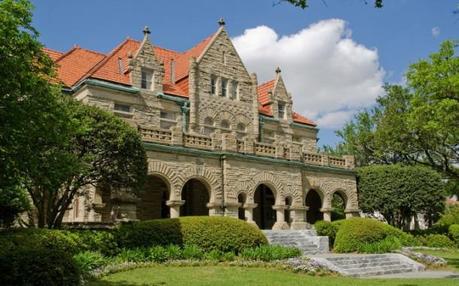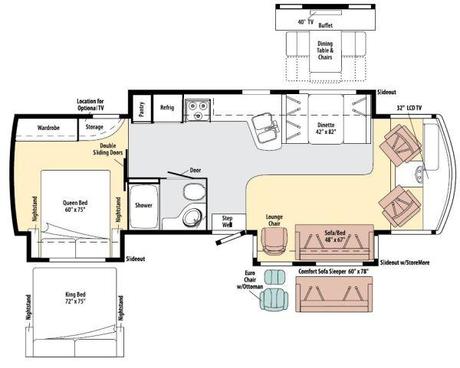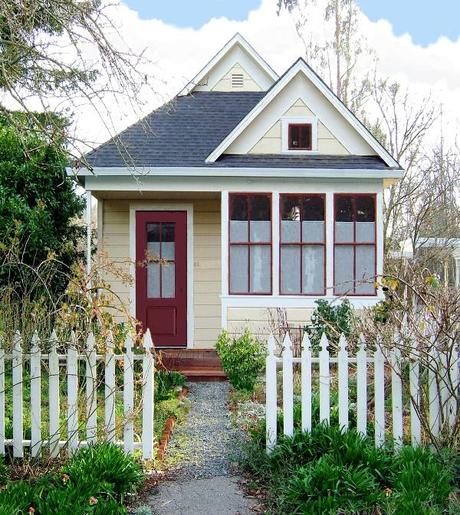
One of the things we always felt pressured by living in the U.S. was the subtle coercion of BIG. Big houses, big cars, big everything. There’s a lot to lament about big. It’s costly, it’s wasteful, it’s demanding. Every square inch of that bigness needs to be maintained and financed. It is, in our view, a horrible waste of time and resources.
Of course our view is a minority one. For the majority, big is desirable, it is status, and even an end onto itself. And because market economies like ours typically give the majority what it wants, we’ve seen a more than doubling of home sizes in the past 60 years. Not only are new homes being built bigger, vintage properties are torn down to make way for giants. In the process the stock of reasonably sized residences has declined, along with the options of the minority who prefer them.
As houses grew, so too did all the stuff that typically fills them. I recall shopping for a washer and dryer and finding only one model that would fit in our now-seemingly palatial 950 sqf apartment. We faced a similar challenge when trying to replace our refrigerator and, more recently, find a vacuum cleaner.
Over the past few decades we’ve marveled at the way our electronics have shrunk in almost magical ways. Often less appreciated is that our appliances have moved in the opposite direction; growing as if on steroids. Meanwhile, our apartment, which we assiduously avoided upsizing, stayed the same size making the new behemoth appliances practically useless to us. The message was clear: bigger isn’t just better, it is unavoidable. Resistance is futile.

The efficient design of our 280 sqf living space provides more than enough room for two people.
Yet things that can’t continue forever eventually won’t. That day for America’s ever-growing floor plan seems to have arrived in the form of the Great Recession. With the Joneses so obviously upside down on their mortgage and facing the marital and other woes that accompany financial stress, many of the rest of us began to wonder why we ever chased after those awful Joneses in the first place. Clearly they’re idiots.
And so, for a time at least, the average size of new homes built in the U.S. actually declined. But what’s surprising is that we didn’t just build slightly smaller big houses, a niche of truly tiny residences – less than 500 sqf – started to gain favor too.
Micro-homes, as they’re often called, aren’t entirely new. The modern version dates back at least as far as 1997 when Jay Shafer built his 89 sqf abode named Tumbleweed. Over the years he’s produced and promoted a variety of blueprints for homes that take Sarah Susanka’s concept of “The Not So Big House,” which emphasizes quality over quantity, to the extreme. Gone are dining rooms and mud rooms and wasted space of all kinds; replaced with compact efficiency. Resembling nothing more than elaborate playhouses, Jay’s designs have often been used as extensions to larger homes and as vacation cottages.
In recent years, though, they’ve also found a place as primary residences. In fact, tiny houses are now popping up everywhere; from Portland, Oregon and Seattle to Washington D.C. and New York. This past July, New York City Mayor Michael Bloomberg announced plans to commission an entire apartment building where most of the units will measure just 300 square feet.

Tumbleweed’s Harbringer cottage comes as a 310 sqf studio or 404 sqf one-bedroom.
An obvious driver behind this miniaturization of the modern home is affordability and not just in perennially expensive zip codes like those found in NYC. After four years of grinding recession and tepid recovery, people nationwide are tiring of living with relatives and are seeking other options. Micro-homes, which can often be built for the price of a typical down payment, are increasingly seen as one such option.
Changing demographics are playing an important roll too. Family sizes have been getting smaller for generations. In his July announcement Mayor Bloomberg noted that the city had almost twice as many one and two person households as it does one bedroom and studio apartments. It is hoped that the city’s micro-apartment project will demonstrate a commercially viable way of fixing that imbalance.
Another demographic engine driving toward small is the bubble of boomers who may be looking to downsize in retirement. Add in the continuing economic challenges of high unemployment, stagnated wages and generally modest American savings, and it’s easy to see why some are saying that the time of the tiny house is finally at hand.
As more people downsize their lives an interesting thing happens, they discover the richness of living small. The Berzin family, who built a 168 sqf home in Virginia’s Blue Ridge Mountains, told CNN that “living mortgage-free has given us the freedom to make decisions based on what will make us happy, not what we have to do to pay the mortgage.”
We couldn’t agree more.

